List of Frankish kings facts for kids
The Franks were a group of Germanic-speaking people. They moved into the Western Roman Empire in the 400s. At first, they were led by people called dukes and "reguli" (which means little kings). The most famous early group of Franks was the Salian Merovingians. They took over most of Roman Gaul (which is now France) and parts of the Visigothic Kingdom in 507 AD.
The sons of Clovis I, who was the first King of the Franks, conquered the Burgundian and Alamanni kingdoms. They also gained control of Provence. They even made the people of Bavarii and Thuringii their allies. Later, in the 700s, the Merovingians were replaced by a new family, the Carolingian dynasty. By the late 900s, other families had replaced the Carolingians in many parts of their lands.
It's been tricky to track all the Frankish rulers. This is because, in old Germanic traditions, the kingdom was often split among a king's sons when he died. But these lands were often brought back together later through marriages, agreements, or wars. There were often many Frankish kings ruling different areas, and the way the lands were divided changed a lot over time.
As traditions for passing down land changed, the different parts of Francia (the lands of the Franks) started to become more permanent kingdoms. West Francia became the main part of what would later be the Kingdom of France. East Francia grew into the Kingdom of Germany. And Middle Francia split into the Kingdom of Lotharingia in the north, the Kingdom of Italy in the south, and the Kingdom of Provence in the west. Soon, West and East Francia divided up the Middle Francia area between them.
The idea of a "King of the Franks" (Rex Francorum) slowly faded away. This title was used in France until 1190. For queens, "Queen of the Franks" was used until 1227. This change showed that kings were no longer just leaders of a group of people. Instead, they were seen as rulers tied to a specific territory.
Contents
Early Frankish Leaders
Before the Merovingian kings, there were several early Frankish leaders. They were often called "dukes" or "kings." These leaders helped shape the early Frankish lands.
- Genobaud (around the 200s)
- Merogais & Ascaric (300s)
- Marcomer (300s), a duke
- Sunno (300s), a duke
- Genobaud (300s), a duke
- Mallobaudes (300s)
- Theodemer (400s)
- Ragnachar (died around 509), killed by Clovis
- Chararic (died around 509), killed by Clovis
Salian Franks
The Salian Franks were a very important group.
- Chlodio (400s)
- Merovech (around 450–457), possibly Chlodio's son
- Childeric I (around 457–481), Merovech's son
- Clovis I (around 481–511), the first Merovingian king. He united all the Franks by 509.
Ripuarian Franks
Another group of Franks was the Ripuarian Franks.
- Childebert (400s)
- Sigobert the Lame (died around 509), killed because Clovis wanted him gone.
- Chlodoric the Parricide (died around 509), Sigobert's son, killed by Clovis.
Merovingian Dynasty
This family ruled the Franks for a long time.
Early Kings of the Franks (509–613)
Clovis I brought all the small Frankish kingdoms together. He also took over most of Roman Gaul. He conquered the lands of the Roman general Syagrius and the Visigothic Kingdom of Toulouse. Clovis made Paris his main city. Other important cities were Soissons, Reims, Metz, and Orléans.
When Clovis died, his four sons, and later his grandsons, split the kingdom. Each son received a part of the original Frankish land and some of the newly conquered Aquitaine.
| Name Reign |
Portrait | Notes |
|---|---|---|
| Clovis I 509–511 |
 |
United all Franks by 509. |
| Theuderic I 511–534 |
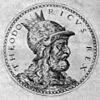 |
Son of Clovis I. Ruled from Reims. |
| Chlodomer 511–524 |
 |
Son of Clovis I. Ruled from Orleans. Conquered Burgundy. |
| Childebert I 511–558 |
 |
Son of Clovis I. Ruled from Paris. |
| Chlothar I 511–561 |
 |
Son of Clovis I. Ruled from Soissons. He reunited the kingdom in 558. |
| Theudebert I 534–548 |
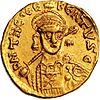 |
Son of Theuderic I. Ruled from Reims. |
| Theudebald 548–555 |
Son of Theudebert I. Ruled from Reims. | |
| Charibert I 561–567 |
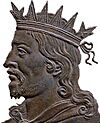 |
Son of Chlothar I. Ruled from Paris. |
| Guntram 561–592 |
Son of Chlothar I. Ruled Burgundy. | |
| Sigebert I 561–575 |
 |
Son of Chlothar I. Ruled from Reims and Metz. |
| Chilperic I 561–584 |
 |
Son of Chlothar I. Ruled from Soissons. |
| Childebert II 575–595 |
 |
Son of Sigebert I. His mother, Brunhilda, helped him rule. He inherited Burgundy. |
| Chlothar II 584–629 |
 |
Son of Chilperic I. His mother, Fredegunde, helped him rule. He reunited the kingdom. |
| Theudebert II 595–612 |
Son of Childebert II. His grandmother, Brunhilda, helped him rule. | |
| Theuderic II 612–613 |
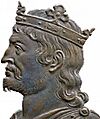 |
Son of Childebert II. Ruled Burgundy and conquered Austrasia. |
| Sigebert II 613 |
Son of Theuderic II. Ruled with his great-grandmother Brunhilda. |
Kings in Neustria and Burgundy (613–679)
Chlothar II defeated Brunhilda and her great-grandson, Sigibert II. This brought the kingdom back together. By this time, the regions of Neustria, Burgundy, and Austrasia had their own unique identities. To keep the local nobles happy, Austrasia was often ruled by a separate king. This king was usually a son or brother of the main king ruling Neustria and Burgundy.
| Name Reign |
Portrait | Notes |
|---|---|---|
| Chlothar II 584–629 |
 |
Reunited the kingdom. |
| Dagobert I 629–639 |
 |
Son of Chlothar II. He was also King in Austrasia from 623-634. |
| Charibert II 629–632 |
 |
Son of Chlothar II. He ruled Aquitaine. |
| Clovis II 639–657 |
 |
Son of Dagobert I. |
| Chlothar III 657–673 |
Son of Clovis II. | |
| Theuderic III 673 |
 |
Son of Clovis II. |
| Clovis (III) 675–676 |
Son of Chlothar III. He claimed rule in Neustria and Burgundy. | |
| Childeric II 673–675 |
Son of Clovis II. He was King in Austrasia from 662-675. | |
| Theuderic III 675–691 |
 |
Son of Clovis II. He also became king in Austrasia after 679. |
Kings in Austrasia (623–679)
After Chlothar II reunited the kingdom in 613, the regions of Neustria, Burgundy, and Austrasia had their own identities. To keep the local nobles happy, Chlothar made his young son, Dagobert I, king of Austrasia. For many decades, Austrasia was usually ruled by a separate king, often a son or brother of the king ruling in Neustria and Burgundy.
| Name Reign |
Portrait | Notes |
|---|---|---|
| Dagobert I 623–634 |
 |
Son of Chlothar II. After 629, he was also King in Neustria and Burgundy. |
| Sigebert III 634–656 |
 |
Son of Dagobert I. |
| Childebert The Adopted 656–661 |
 |
Adopted son of Sigebert III. |
| Chlothar III 661–662 |
Son of Clovis II. He was also King in Neustria and Burgundy. | |
| Childeric II 662–675 |
Son of Clovis II. After 673, he was also King in Neustria and Burgundy. | |
| Clovis (III) 675–676 |
Son of Chlothar III. He claimed rule in Neustria and Burgundy. | |
| Dagobert II 676–679 |
 |
Son of Sigebert III. |
Later Kings of the Franks (679–751)
Theuderic III was recognized as king of all the Franks in 679. From then on, the Frankish kingdom was mostly united. This time period is known for the roi fainéant, or "do-nothing kings." These kings had less and less power. The real power was held by their chief ministers, called mayors of the palace.
| Name Reign |
Portrait | Notes | |||
|---|---|---|---|---|---|
| Theuderic III 675–691 |
 |
Recognized as king of all Franks after 679. | |||
| Clovis IV 691–695 |
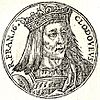 |
Son of Theuderic III. | |||
| Childebert III The Just 695–711 |
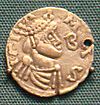 |
Son of Theuderic III. | |||
| Dagobert III 711–715 |
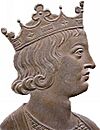 |
Son of Childebert III. | |||
| Chilperic II Daniel 715–721 |
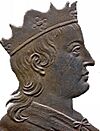 |
Son of Childeric II. | |||
| Theuderic IV 721–737 |
 |
Son of Dagobert III. | |||
| No king (737–741) – Charles Martel ruled as a powerful prince. | |||||
| Childeric III 741–751 |
 |
The last Merovingian king. | |||
Carolingian Dynasty
The Carolingians started out as the powerful mayors of the palace under the Merovingian kings. They gained more and more control. In 687, Pepin of Heristal became very powerful after winning the Battle of Tertry. People at the time saw this as the start of his rule.
Later, in 747, Pepin the Short became Mayor of the Palace for both Austrasia and Neustria. This made him the ruler of the entire Frankish kingdom. He arranged for the Merovingian king, Childeric III, to be removed from power. In March 752, Pepin himself was crowned King of the Franks. The role of Mayor was then combined with the King's role. This marked the beginning of the Carolingian family as the ruling dynasty.
| Name Reign |
Portrait | Notes |
|---|---|---|
| Pepin The Short 751–768 |
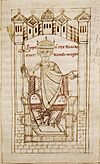 |
First Carolingian King. Chosen by Frankish nobles. |
| Charles I The Great "Charlemagne" 768–814 |
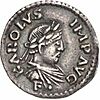 |
Son of Pepin the Short. A very famous and powerful ruler. |
| Carloman I 768–771 |
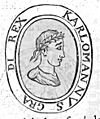 |
Son of Pepin the Short. Ruled jointly with Charlemagne for a short time. |
| Louis I The Pious 814–840 |
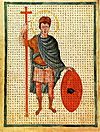 |
Son of Charlemagne. He made many divisions of his empire. |
Louis the Pious divided his large empire many times during his life. His last division, made in Worms in 838, gave Charles the Bald the western lands (including Aquitaine). Lothair received the eastern lands (including Italy, but not Bavaria). Bavaria was given to Louis the German.
However, after Louis the Pious died in 840, a civil war broke out. It lasted for three years. The Frankish kingdom was then formally divided by the Treaty of Verdun in 843.
- Lothair kept his title of Emperor and his Kingdom of Italy. He also received the new Kingdom of Middle Francia. This was a strip of land stretching from Italy to the North Sea, including the Low Countries, the Rhineland, Burgundy, and Provence.
- Charles the Bald was confirmed as ruler of Aquitaine and received West Francia (which is modern France). This was the land west of Lothair's kingdom.
- Louis the German was confirmed as ruler of Bavaria and received East Francia (which is modern Germany). This was the land east of Lothair's kingdom.
This division led to the formation of separate kingdoms that would eventually become France and Germany.
|
|
|
See also
- Historia Francorum (History of the Franks)
- List of French monarchs
Images for kids



